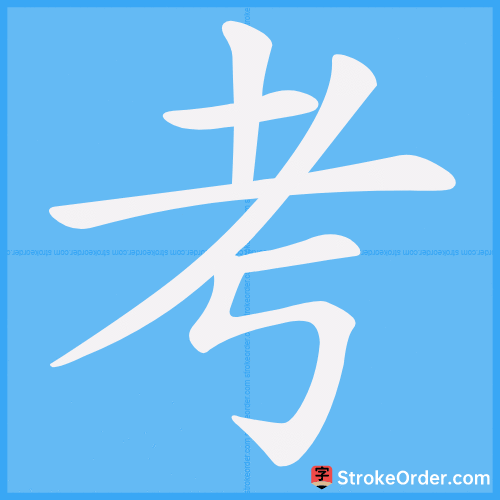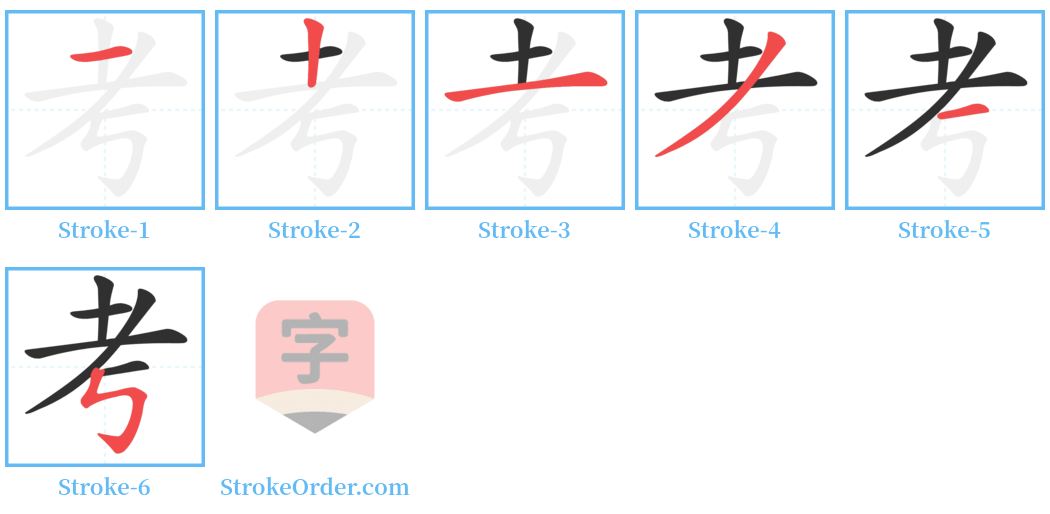考 Stroke Order
Animated Stroke Order of 考

Stroke Order Diagrams for 考

Step-by-Step Handwriting Guide for 考

Learn to Write Chinese Characters with Video Tutorials
Watch the video of writing the Chinese character "考", learn the correct stroke order (笔顺) of the character "考", and master the standard way of writing the character "考".
Free Printable Handwriting Practice with Stroke Order: 考
Printable Writing Practice Worksheet of "考" in Portrait Orientation (Tian Zi Ge)

Printable Writing Practice Worksheet of "考" in Landscape Orientation (Tian Zi Ge)

Information of 考
Pinyin
kǎo
Radical
耂
Strokes
6 strokes
Usage
★★★★★
Definition
to check / to verify / to test / to examine
考 [kǎo]
1. 시험, 테스트: 考试, 考查.
Test, examination: exam, check.
2. 검사, 검토: 考察, 考勤, 稽考, 考核.
Inspect, verify: inspection, attendance check, review, audit.
3. 추구, 연구: 考古, 考据, 考订, 考证.
Pursue, study: archaeology, textual research, editorial revision, verification.
4. 나이 많음: 寿考.
Old age: longevity.
5. 원래 아버지를 의미, 후에 주로 고인이 된 아버지를 지칭: 先考, 如丧考妣.
Originally refers to father, later often refers to deceased father: late father, as in mourning for deceased parents.
6. 치다, 두드리다: “而陋者乃以斧斤考击而求之,自以为得其实”.
Hit, strike: "the crude ones sought it by striking with axes and thought they obtained the essence."
考 [kǎo]
1. 고인이 된 아버지: [En.] deceased father.
Deceased father: [En.] deceased father.
考 [kǎo]
1. '攷'로 잘못 사용됨. 치다, 두드리다: [En.] strike; beat.
Wrongly used as '攷'. Strike, hit: [En.] strike; beat.
2. '拷'로 잘못 사용됨. 고문하다: [En.] torture.
Wrongly used as '拷'. Torture: [En.] torture.
3. 검사하다, 시험하다: [En.] examine; check.
Examine, test: [En.] examine; check.
4. 조사하다, 점검하다: [En.] inspect; check.
Inspect, check: [En.] inspect; check.
5. 완성하다; 건설하다: [En.] complete; build up.
Complete; build: [En.] complete; build up.
考 [kǎo]
形. 본의: 나이 많고 늙음.
Meaning: old, aged.
造字法: 형성 문자, '老(늙은)', '丂' 음. 갑골문 및 금문 모두 구부린 노인의 모습을 의미함, 늙음과 동의어.
Character construction method: phono-semantic compound, with '老' (old) and '丂' (sounds like kǎo). The oracle bone script and bronze inscriptions depict a hunchbacked old man walking with a cane, synonymous with aging.
引:
1. 《说文》:考,老也.
"Shuōwén": '考' means old.
2. 《新唐书》:富贵寿考.
"New Book of Tang": rich and noble longevity.
例:
논의: 考寿 (long life); 考终 (to live to a ripe old age).
Example: long life; to live to a ripe old age.
名. 고인이 된 아버지.
Meaning: deceased father.
引:
《尔雅》:父为考.
"Yǐr yǎ": Father is referred to as '考'.
例:
논의: 考妣 (父称考,母称妣,古为生前通称; 今人则称死去的父母为考妣).
Example: '考妣' (Father is referred to as '考', mother is referred to as '妣'; in ancient times this was a common term before death; nowadays it refers to deceased parents as '考妣').
动.
引:
1. 《诗·唐风·山有枢》:子有钟鼓,弗鼓弗考.
"Book of Songs": If a son has bells and drums, he won't play them or strike.
2. 《庄子·天地》:金石有声,不考不鸣.
"Zhuangzi": The sound of metal and stone won't ring if not struck.
例:
예: 考击 (두드리다); 考考 (두드리는 소리).
Example: to strike; sound of beating.
2. 잘못 사용됨 '拷'. 고문하다: [En.] torture.
Wrongly used as '拷'. Torture: [En.] torture.
例:
예: 考竟 (고문으로 죽다).
Example: [En.] die from torture; die due to questioning.
3. 검사하다, 시험하다: [En.] examine; check.
Examine, test: [En.] examine; check.
例:
예: 考较 (검증하다).
Example: assess; verify.
4. 조사하다, 점검하다: [En.] inspect; check.
Inspect, check: [En.] inspect; check.
例:
예: 考据 (기초를 바탕으로 조사 학적 증명).
Example: textual research; verification based on evidence.
5. 완성; 건설: [En.] complete; build.
Complete; build: [En.] complete; build up.
例:
예: 考落 (건설); 考成 (완성).
Example: completion; built.
wear a funeral face as if newly bereft of both parents / be grief-stricken as if bereaved of parents / grieved as if one had lost parents
college entrance exam (especially as abbr. for 普通高等學校招生全國統一考試|普通高等学校招生全国统一考试[Pu3 tong1 Gao1 deng3 Xue2 xiao4 Zhao1 sheng1 Quan2 guo2 Tong3 yi1 Kao3 shi4]) / (Tw) entrance exam for senior government service posts (abbr. for 公務人員高等考試|公务人员高等考试)